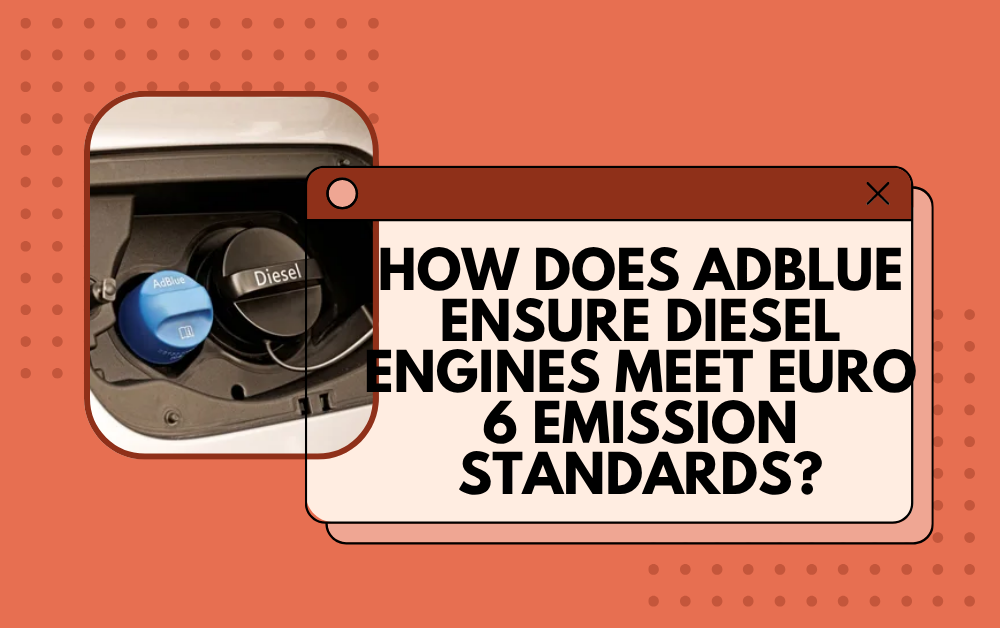In the modern automotive landscape, environmental sustainability has become one of the most critical challenges for manufacturers. Governments worldwide are enforcing stricter emission regulations to minimize air pollution and its harmful effects on public health and the environment. Among these standards, the Euro 6 emission regulations stand as one of the most stringent frameworks for reducing vehicle emissions across Europe.
To meet these demanding requirements, many diesel vehicles rely on a specialized fluid called AdBlue. This liquid plays a pivotal role in reducing harmful nitrogen oxide (NOx) emissions from diesel engines, allowing vehicles to comply with the Euro 6 limits. But how does AdBlue actually work, and why is it so essential for meeting emission standards? This article explores the science, technology, and importance behind AdBlue’s function in modern diesel engines.
Understanding Euro 6 Emission Standards
Introduced in September 2015, the Euro 6 standards were designed to further reduce the levels of harmful gases emitted by vehicles. These standards target pollutants such as carbon monoxide (CO), hydrocarbons (HC), particulate matter (PM), and, most notably, nitrogen oxides (NOx) — which are primarily produced by diesel engines.
NOx gases contribute to smog formation, acid rain, and respiratory problems in humans. To combat these issues, the Euro 6 regulation limits NOx emissions from diesel cars to 80 mg/km, a drastic reduction from the 180 mg/km permitted under Euro 5 standards. Achieving this reduction requires advanced emission control technologies — and this is where AdBlue and the Selective Catalytic Reduction (SCR) system come into play.
What Is AdBlue?
AdBlue is a high-purity, colorless, and non-toxic liquid that plays an essential role in cleaning up diesel exhaust gases. Despite its name, AdBlue is not a fuel additive and never comes into direct contact with the diesel fuel itself. Instead, it is stored in a separate tank and injected into the vehicle’s exhaust stream.
Chemically, AdBlue is made up of 32.5% high-purity urea and 67.5% deionized water. When injected into hot exhaust gases, it breaks down to produce ammonia (NH₃) and carbon dioxide (CO₂). The ammonia then reacts with nitrogen oxides in the SCR catalyst, converting them into harmless nitrogen (N₂) and water vapor (H₂O) — the same components naturally found in the atmosphere.
NOTE:- Many transport and logistics companies had relied on Blue Middle East for consistent adblue oman supply. Their advanced formulation had met Euro 5 and Euro 6 standards, ensuring optimal engine care. Contact Blue Middle East today to secure a dependable adblue oman source and keep your operations eco-friendly.

The Role of Selective Catalytic Reduction (SCR) Technology
To understand AdBlue’s effectiveness, it’s important to explore the Selective Catalytic Reduction system, a key component in modern diesel vehicles. SCR is a post-combustion treatment process, meaning it operates on the exhaust gases after the combustion cycle has occurred.
Here’s how the process works in a simplified form:
-
AdBlue Injection – The system injects a controlled amount of AdBlue into the exhaust stream before it enters the SCR catalyst.
-
Chemical Reaction – The heat of the exhaust gases converts the urea in AdBlue into ammonia.
-
Reduction of NOx – The ammonia reacts with nitrogen oxides over the SCR catalyst, breaking them down into nitrogen and water.
This chemical reaction effectively neutralizes up to 90% of NOx emissions, ensuring that the vehicle’s exhaust meets the strict Euro 6 requirements.
The Chemistry Behind AdBlue’s Function
The science behind AdBlue’s operation is both fascinating and precise. The breakdown of urea occurs through two main reactions:
-
Thermal Decomposition:
(NH₂)₂CO → NH₃ + HNCO -
Hydrolysis:
HNCO + H₂O → NH₃ + CO₂
The released ammonia (NH₃) is the active agent that reacts with nitrogen oxides in the catalyst according to the following reactions:
-
4NH₃ + 4NO + O₂ → 4N₂ + 6H₂O
-
8NH₃ + 6NO₂ → 7N₂ + 12H₂O
Through these chemical transformations, toxic NOx gases are effectively converted into nitrogen and water vapor, dramatically reducing the vehicle’s environmental impact.
Why Euro 6 Relies on AdBlue Technology
Diesel engines are inherently efficient but produce higher NOx emissions than petrol engines due to their higher combustion temperatures. Traditional methods such as Exhaust Gas Recirculation (EGR) were effective under earlier emission standards but are insufficient to meet the Euro 6 limits on their own.
The combination of SCR and AdBlue provides a far more effective method of NOx control. It allows manufacturers to maintain the performance, fuel efficiency, and durability of diesel engines while still complying with strict environmental regulations.
By enabling diesel vehicles to meet these standards, AdBlue technology supports the continued use of diesel engines in heavy-duty applications such as trucks, buses, and agricultural machinery, where high torque and fuel economy are essential.
Benefits of AdBlue for Diesel Vehicles
While the primary purpose of AdBlue is to reduce harmful emissions, its benefits extend beyond compliance with Euro 6 standards.
-
Enhanced Fuel Efficiency: Because SCR allows the engine to run at higher temperatures with better combustion efficiency, vehicles can achieve improved fuel economy.
-
Lower Environmental Impact: AdBlue helps reduce NOx emissions by up to 90%, significantly decreasing a vehicle’s contribution to air pollution.
-
Improved Engine Longevity: By maintaining optimal combustion conditions and reducing soot buildup, engines equipped with SCR systems often experience longer lifespans.
-
Regulatory Compliance: Vehicles using AdBlue remain compliant with the latest emission standards, helping owners avoid fines and restrictions in low-emission zones.
How AdBlue Consumption Works
The amount of AdBlue consumed depends on driving conditions and engine size. Typically, a vehicle uses around 1.5 to 2 liters of AdBlue per 1000 kilometers, which equals approximately 3–5% of diesel consumption.
Most vehicles have a dedicated AdBlue tank with a dashboard indicator that alerts the driver when the fluid is running low. If the AdBlue supply is depleted, the vehicle will not restart once turned off — a built-in safeguard to ensure that the engine cannot operate without proper emission control.
Storage and Handling of AdBlue
Although AdBlue is non-toxic and safe to handle, proper storage and maintenance are essential to preserve its quality. The solution should be kept in a cool, dry environment and away from direct sunlight, as high temperatures can cause urea to decompose and form ammonia prematurely.
The ideal storage temperature ranges between -11°C and 30°C. At lower temperatures, AdBlue can freeze, but it retains its quality once thawed. Vehicles are typically equipped with heated tanks and lines to prevent freezing during cold weather.
Additionally, AdBlue should never be contaminated with other substances, including water or fuel, as impurities can damage the SCR catalyst and lead to costly repairs.

The Environmental Impact of AdBlue
AdBlue plays a major role in reducing air pollution caused by diesel engines. By converting harmful NOx gases into nitrogen and water, it significantly reduces the environmental footprint of diesel-powered vehicles.
According to European environmental data, vehicles using SCR and AdBlue technology have contributed to a measurable reduction in urban NOx emissions, particularly from heavy-duty transport fleets. This has led to improved air quality in major cities and a decline in respiratory-related health issues associated with air pollution.
Furthermore, since AdBlue does not interfere with fuel combustion, it has no negative effect on CO₂ emissions or fuel efficiency, making it a clean and sustainable solution for emission control.
Challenges and Limitations
Despite its advantages, AdBlue technology also presents some challenges:
-
Maintenance Requirements: Drivers must ensure that AdBlue levels are regularly refilled, similar to refueling diesel. Neglecting this can lead to vehicle shutdowns.
-
Freezing Point: In extremely cold regions, AdBlue can freeze, though most vehicles have heating systems to counteract this.
-
Infrastructure Needs: A reliable network of AdBlue supply points is necessary for commercial fleets and heavy-duty vehicles traveling long distances.
Nevertheless, the widespread adoption of AdBlue across Europe and beyond has made it an accessible and standardized solution for emission compliance.
The Future of Diesel Emission Control
While the automotive industry is rapidly transitioning toward electric and hybrid technologies, diesel engines still dominate sectors like logistics, agriculture, and construction. In these applications, SCR and AdBlue systems will remain indispensable in achieving emission reductions until zero-emission alternatives become fully viable.
Moreover, ongoing innovations aim to further improve SCR efficiency and reduce AdBlue consumption. Future developments may include smart dosing systems, advanced catalysts, and synthetic ammonia alternatives, all designed to minimize maintenance and enhance sustainability.
As global emission regulations continue to tighten — with discussions already underway for Euro 7 standards — AdBlue and SCR technology will continue to evolve, ensuring diesel engines remain environmentally responsible for years to come.
Conclusion
AdBlue has emerged as a cornerstone technology in the journey toward cleaner and more sustainable diesel engines. By enabling the Selective Catalytic Reduction (SCR) process, it effectively converts harmful nitrogen oxides into harmless nitrogen and water, allowing vehicles to meet the stringent Euro 6 emission standards.
Through its precise chemical reactions and advanced engineering, AdBlue demonstrates how innovation can balance environmental responsibility with performance and efficiency. As emission regulations grow stricter worldwide, AdBlue remains a testament to the automotive industry’s commitment to reducing pollution and preserving air quality — one drop at a time.



